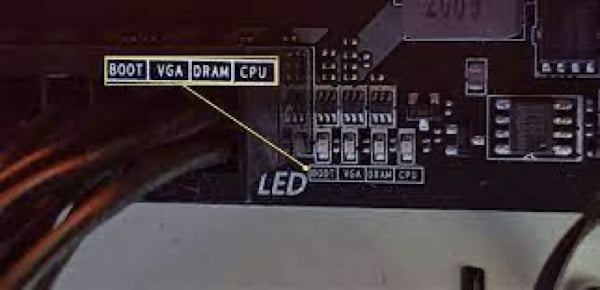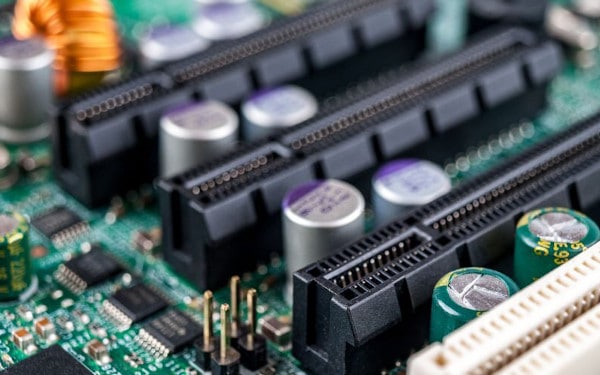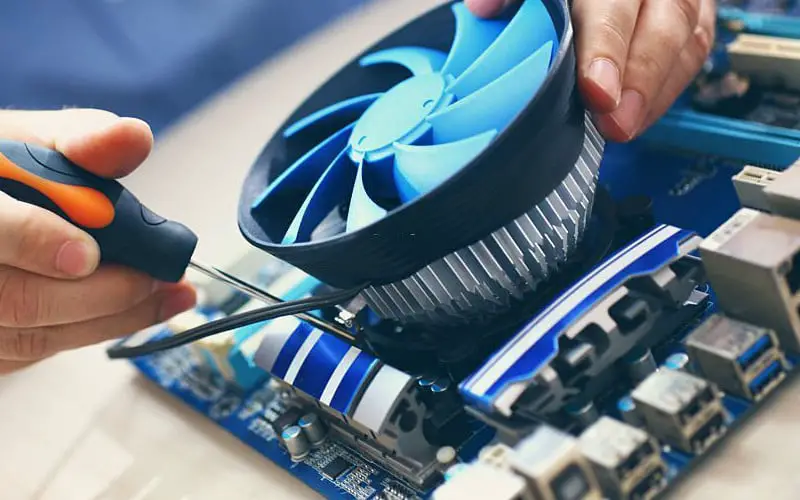You’re probably wondering what to do if the VGA light on the motherboard isn’t working. You’re not the only one who feels this way. This is a typical problem that many people have but don’t know how to fix.
Fortunately, you can take a few simple actions to repair the situation. We’ll explain what causes the light to turn on, how to troubleshoot it, and how to prevent the problem from happening again.
What is the VGA Light on the Motherboard?
VGA lights on the motherboard are present there to indicate malfunctioning hardware. If hardware, most commonly the GPU (Graphics Processing Unit), is not running correctly, the light will turn on until the error is fixed.
If you have an ASUS or MSI motherboard and you see a white VGA light, this is likely the cause of the issue, and you should take action accordingly. Depending on the manufacturing year, motherboards may have multiple LEDs on the board for specific CPU components to detect the issue quickly.
Older models mostly have one light on their motherboards. Whenever the light is turned on, it must go through all the computer components to detect what is wrong. Newer models come with several LEDs on the motherboard connected with different computer parts, such as the CPU, RAM, GPU, and Boot.

The motherboard is an essential part of any desktop computer, and when it starts acting up, it can be pretty frustrating.
One of the most common issues is when the VGA light on the motherboard stays on even when there’s no video signal from the computer. This usually means something wrong with the video card or with the connection between the video card and the motherboard.
Let’s look at an overview of the different LEDs on the motherboard for other components.
Central Processing Unit
It is the main component of the computer that is present in the center of the motherboard. If there is any problem with the CPU, a red light turns on the CPU, indicating that the system cannot detect the CPU.
There are multiple reasons for the light to be lit, such as the CPU fan not being correctly plugged in, the CMOS battery running out, and it needs charging.
Random Access Memory
If the red led on the motherboard turns on for the RAM, the system does not detect the RAM. To fix this, check your RAM and ensure they are correctly inserted in their slots. The clamps that set the RAM on the places must be properly locked, and a clicking noise should come when appropriately selected.
Graphics Processing Unit
The system does not detect the graphics card when the red-lit comes on for the GPU. You must check if the card is correctly plugged into the PCIe slot and the power connectors are perfectly placed.
Boot
Whenever a red light is lit for the BOOT, the Boot devices cannot be detected by the CPU. To fix this issue, you must check your storage devices and see if there are any loose connections.
How to Fix the VGA Light on the Motherboard?
Before fixing the VGA, you should ensure that everything is working perfectly. The compatibility of the motherboard and the graphic needs to be checked first. If one of the components is outdated or does not work, the light will turn on.
Let’s get on with the VGA light fixes, but before we move ahead, check out this video for a more precise idea.
Power Supply
The power supply is the main component of the CPU that helps provide power to the parts for them to work. The first thing you should do is check the power supply. Ensure it is properly plugged in and the voltage is set to the correct level. If it is not, you will need to replace the power supply.
Some components may stop working if there is a low voltage or disrupt the current flow. Your system needs an adequate PSU to work efficiently. Various online Power Supply Calculators show the requirement of your system’s supply.
Check the Hardware
Every hardware is interconnected with the VGA Light. The light may turn on if there is any problem with a single component. Removing all hardware is recommended to determine where the problem arises.
After removing all the hardware, place each one by one to see where the problem arises.
Graphics Cards Placement
The graphic card needs to be appropriately placed. Otherwise, the VGA lights may turn on if loose on the PCIe slot. Therefore, removing the graphic card by removing all the cables connected to it and detaching it from the PCIe slot is recommended.
After removing the card, re-insert it again and check if it’s fixed correctly in the place.
Turn On the PC Without the Graphic Card
Many systems run the Intel processor, and it can boot the system without any dedicated graphics card as it has its dedicated graphic card. If the PC runs fine without plugging the graphic card, you must replace it to function correctly.
Check for Damages
If your PC gets damaged from a fall or any other unforeseen circumstance, there is a high chance that the PCIe slot or the GPU may stop working, as the motherboard would not detect it. The Graphic Card contains a connector, which, if it gets damaged, may affect the communication between the motherboard and the graphic card may halt.
There are small delicate gold-plated lines on the connector, and communication will happen even if a single line gets damaged.
Although there might be a chance that your gold-plated lines can get stained due to extensive use, it is recommended that you clean them properly with cotton and rubbing alcohol. Otherwise, it would need to be changed completely.
Check For Any Stains on the PCIe
Fixing VGA lights on the motherboard is not a daunting task. However, there are many possible reasons for this issue, and some essential troubleshooting tips can help you resolve the problem. In this article, we will explore some of these solutions.
First, check for any stains or dirt on the PCIe slots on your motherboard. If there is, then use a soft cloth to clean it off. Ensure there is no accumulated dust around the video card and its ports. You can do this by using a compressed air duster.
If the video card is damaged in any way, then you will need to replace it. Consult with your hardware vendor to find the exact model of the video card compatible with your motherboard.

BIOS Setting
The BIOS (Basic Input/output system) is the most important component for improving a computer system. It lets you turn the components connected to your motherboard on or off. A change in the BIOS setting might result in errors. However, resetting the entire BIOS to its factory default can resolve this problem quickly.
There are various ways to reset the BIOS setting. The most common method is resetting the BIOS setting by directly assessing it and resetting it using the Complementary Metal Oxide Semiconductor, which stores the BIOS setting in a small device.
Another way is by resetting the BIOS setting through a CMOS Jumper.
Update the BIOS
Mostly the VGA Lights issue gets fixed after a BIOS update, as an old running software can malfunction after a given time. You can easily update the BIOS setting using the flash BIOS button on the Input/Output Panel.
Check Everything
To fix the VGA light, you first need to unplug everything. There are different steps that you need to follow one by one.
- Reconnect the power cord.
- Check that the video card is seated correctly.
- Reseat the RAM.
- Replace the CMOS battery.
- Test the PSU.
If all those steps don’t work, it might be time to bring your computer in for repair. Problems with the solder joints cause many motherboard issues, which a professional can only fix.
If your computer is still under warranty, you might consider sending it in for repair. Otherwise, you can try to fix the motherboard yourself, but it’s not recommended for beginners.
What Benefits Do ASUS Motherboards Have?
ASUS motherboards have several advantages, making them a preferred choice for many users. For one, they offer enhanced security through the Trusted Platform Module (TPM) chip, ensuring that only legitimate hardware devices are connected to the network.
The ASUS secure boot feature also offers protection against malicious networks that can implant harmful software.
Another benefit of ASUS Motherboards is their better reliability. The motherboard has features that control temperature and humidity levels, thus ensuring consistent and smooth performance without slowing down or breaking. The BIOS chip in the motherboard is also designed to clear out corrupt updates independently.
ASUS Motherboards are also known for their better management capabilities. They have features that are easy to install and use, with the management suite allowing for simple customization and the recording of hardware status even during abnormal changes. Moreover, the motherboards come fitted with special Q-slots that make it easy and safe to remove RAM during replacement.
Can a Graphics Card Destroy a Motherboard?
It is doubtful that your graphics card can destroy a motherboard. Although if the graphic card is not placed correctly, there is a chance that it can have faulty soldering and create electric arcs, which can destroy the motherboard. A blown GPU can also destroy a motherboard.
In general, if a graphics card fails, it will likely cause the motherboard to fail. This is because the graphics card is responsible for processing all the information that goes to the monitor, and if something goes wrong with the graphics card, it can cause the motherboard to overheat. This is especially true if the graphics card is overclocked.
There are a few things you can do to minimize the risk of your graphics card damaging your motherboard:
- Ensure your case has good ventilation and plenty of airflow around the graphics card.
- Ensure you use a high-quality power supply and that it is properly matched to your graphics card.
- Regularly check the condition of your graphics card and motherboard, and replace them if they are starting to show signs of wear.
Conclusion
The VGA light is usually for a specific purpose that helps trace the CPU errors. The different colored VGA lights show various problems, which can be analyzed by color. You can apply particular fixes after determining the error in the motherboard through the light.
It is recommended to properly check the spots to prevent any other unforeseen mistakes in the future.
Frequently Asked Questions
Why is My VGA White Light On?
If you have a solid white VGA led light on the motherboard, your system cannot find any video display. You should power off, re-insert the GPU, and connect all the cords as usual.
After turning on the CPU, your PC will be good as usual again.
What Does the Green Light Mean on the Motherboard?
When the green light on the motherboard comes on, it indicates that the power supply is providing full current to the system’s components. If a technician touches any component while this is lit, he or she may receive an electric shock since it also serves as a warning light.
The second purpose of the green light is to show whether the current is being supplied to the system. If the power is plugged in and the green light doesn’t come on, there is a problem with the electricity supply line.
What Does the Orange Light Mean on the Motherboard?
There are a few reasons why the orange light is on. The orange light indicates a hardware issue or an issue with the motherboard. A software bug or an operating system malfunction doesn’t cause this problem.
Can You Fry a Motherboard by Touching It?
The human body is capable of producing static electricity discharge. As a result, if you touch the motherboard with your hands, the electrical components may be damaged. It is advised that you properly ground yourself before connecting the parts.
What Happens If a Graphics Card Dies?
If you have an AMD processor system, the GPU is the main component that would help turn on the system. But if the graphic card dies, your system will not turn on.
However, if the failed graphics card is an Intel processor, your system will turn on, but it won’t run any software or application that uses a graphics card. There would be evident off-color pixelation, screen flickers, random artifacts, and screen glitches hamper the user interface.
If you think your graphics card might be on the way out, there are a few things you can do to test it and prolong its life.
Here’s what you need to know about what happens if a graphics card dies. One of the first signs that a graphics card is starting to fail is stability issues. You might experience crashes, blue screens, or system freezes.
Testing your graphics card for problems is good if you see any of these symptoms.
There are a few ways to do this. You can run a diagnostic program like FurMark or MSI Kombustor to test your graphics card’s performance and stability. You can also check your system’s event logs for any errors related to your graphics card.






